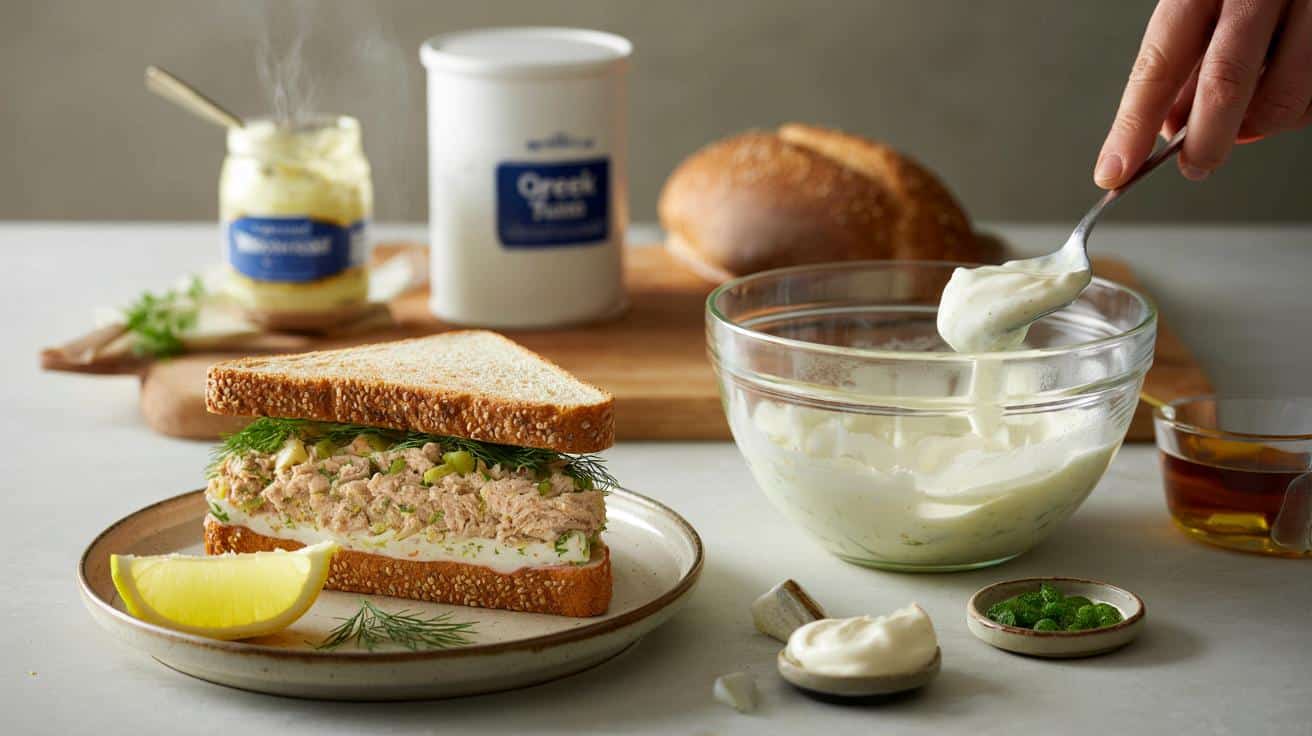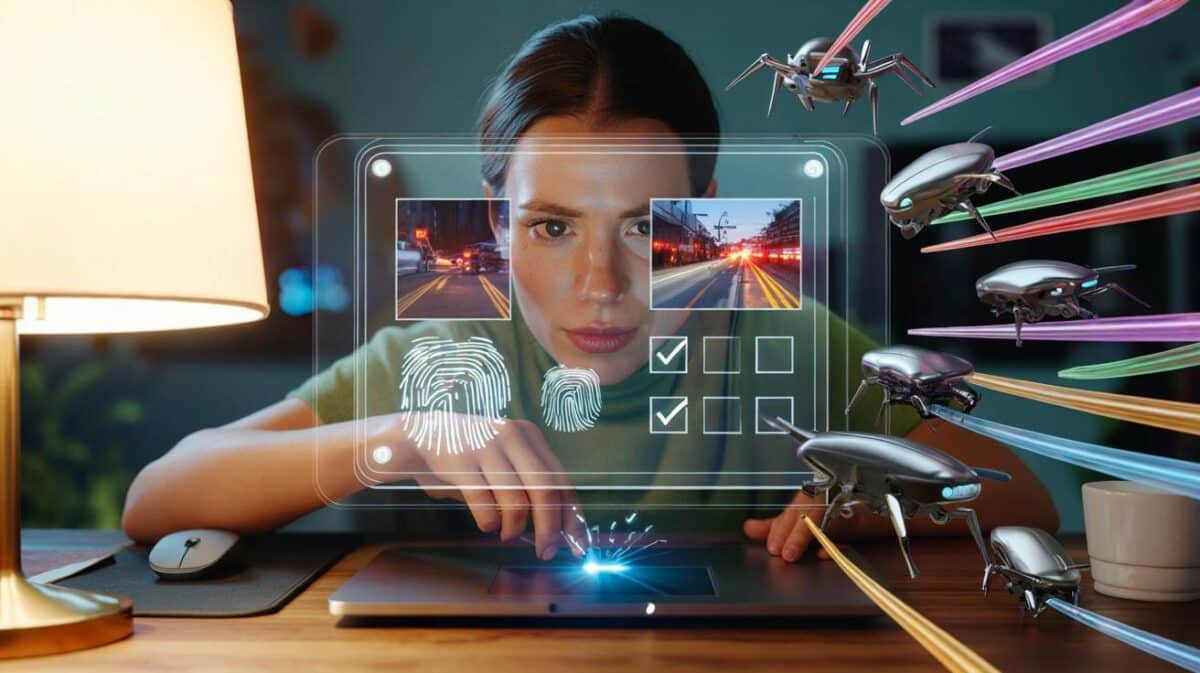Millions reach for tuna between slices each midday. It’s cheap, protein-rich and quick. Yet habit often leads to a heavy squeeze of mayonnaise. A lighter, creamier alternative now has home cooks rethinking the mix, and the numbers will make you pause before your next dollop.
The one-ingredient switch making waves
Greek yoghurt stands in for mayonnaise without gutting the texture people love. It brings body, gentle tang and welcome protein. The result stays rich and spreadable, but fresher on the palate. For many households, this switch cuts lunchtime calories and keeps hunger at bay longer.
Swap 2 tablespoons of mayonnaise for Greek yoghurt and save roughly 150–180 kcal per sandwich, while adding extra protein.
That saving mounts quickly over a working week. The flavour shift also helps. The lactic acidity in yoghurt wakes up tuna’s savoury notes, so you get lift rather than flat heft. Those who prefer a rounder, richer feel can use a 2–5% fat Greek yoghurt; the extra fat softens the tang and improves cling.
How the numbers stack up
Typical nutrition per 2 tablespoons (about 30g). Values are approximate and vary by brand.
| Ingredient | Calories | Fat | Protein |
|---|---|---|---|
| Real mayonnaise | 190–210 kcal | 20–22g | 0–0.5g |
| Greek yoghurt, 5% fat | 25–40 kcal | 1–2g | 2–3g |
| Greek yoghurt, 0–2% fat | 20–30 kcal | 0–1g | 3–4g |
Even with a fuller-fat yoghurt, you still slash calories and saturated fat compared with mayonnaise, while gaining a little protein and live cultures. Those cultures can support a healthy gut, which many office-bound diets lack.
Texture and flavour: why it works
Yoghurt’s thickness comes from straining, which concentrates milk solids. That gives body similar to an emulsion, so it binds tuna into a cohesive, spoonable salad. The mild acidity brightens rather than dulls. A pinch of salt balances the tang and makes the fish taste sweeter. If you miss mayo’s glossy richness, whisk in a teaspoon of extra-virgin olive oil; you’ll keep a silky mouthfeel without the heavy hit.
The trick is simple: thick yoghurt for structure, a touch of acid for brightness, optional olive oil for roundness.
How to build a better tuna sandwich
Your 3-minute method
- Drain one tin of tuna packed in spring water until nearly dry.
- Stir in 2 tablespoons Greek yoghurt (2–5% fat works well for balance).
- Season with sea salt and black pepper. Add a squeeze of lemon.
- Optional: 1 teaspoon Dijon mustard for bite, 1 teaspoon olive oil for silk.
- Fold through fine-chopped celery or red onion for crunch.
- Pile onto wholegrain bread, a seeded roll or a warm jacket potato.
Flavour boosters that love tuna
- Capers or finely chopped cornichons for briny pop.
- Fresh dill, parsley or chives to add lift.
- Sweetcorn for texture and a touch of sweetness.
- Smoked paprika or chilli flakes if you want gentle heat.
- Lemon zest for aroma without extra liquid.
Which tuna and which yoghurt?
Choose tuna in water when mixing with yoghurt; it keeps control over fat and texture. If you prefer oil-packed tuna, drain well and skip any added olive oil. For flavour, white albacore tastes mild and meaty; skipjack brings more assertive fishiness and smaller flakes. Check labels for sustainability marks if that matters to you.
On yoghurt, a 5% tub delivers creamy, satiating results that still undercut mayo. A 2% pot gives a leaner profile while holding shape. Zero-fat yoghurt can turn sharp and a little thin; strain it briefly through kitchen paper if needed.
Health notes and food safety
Tuna brings high-quality protein and omega-3s. Yoghurt adds calcium and live cultures. Mayonnaise contributes mostly fat and energy, which some people enjoy for satiety but many would rather moderate at lunchtime.
If you are pregnant, current UK guidance advises limiting tuna due to mercury: think up to four medium cans a week or two tuna steaks.
Keep mixed tuna chilled and eat within two days. Use clean utensils and avoid leaving a made sandwich at room temperature for long stretches. If salt intake concerns you, taste before seasoning; tuna can be salty out of the tin. Dairy allergy or lactose sensitivity? Consider a lactose-free Greek-style yoghurt, or use a small amount of olive oil plus lemon as an alternative binder.
Cost and convenience
A 500g tub of Greek yoghurt often costs around £1.30–£2 in major supermarkets. At 30g per sandwich, that’s roughly 8–12 pence per serving. Branded mayonnaise can run higher per spoonful, especially outside promotions. Yoghurt also doubles up for breakfast and marinades, so it rarely languishes at the back of the fridge.
Beyond the sandwich
- Toss cooked pasta with tuna, Greek yoghurt, peas and herbs for a quick pasta salad.
- Top a baked potato with the yoghurt-tuna mix and chives.
- Roll into a wholemeal wrap with shredded lettuce and sliced tomatoes.
- Spoon over crunchy lettuce, cucumber and olives for a five-minute salad bowl.
A quick taste test you can run at home
Make two mixes: one with 2 tbsp mayonnaise, the other with 2 tbsp 5% Greek yoghurt. Add the same salt, pepper and lemon to both. Spread on identical bread. Notice the differences: the yoghurt version should feel lighter, cleaner and more aromatic. The mayo version will coat the palate more heavily and mute acidity. Now combine approaches—use yoghurt as the base, then add a teaspoon of olive oil if you crave gloss. Most people land on that as the sweet spot.
Troubleshooting and small adjustments
- Too tangy? Use 5% yoghurt and a pinch of sugar, or cut lemon to a few drops.
- Too loose? Add another forkful of drained tuna or stir in a teaspoon of fine breadcrumbs.
- Too dry? A teaspoon of olive oil or a splash of the tuna’s packing water fixes it.
- Not savoury enough? A dash of Worcestershire sauce or soy sauce sharpens umami quickly.
For many readers, the winning formula is simple: 1 tin tuna + 2 tbsp Greek yoghurt + lemon + herbs. Cheap, quick, satisfying.
A sample macro check for your lunch
Try this for a typical sandwich: two slices wholegrain bread, one 145g can tuna in water (drained), 2 tbsp 5% Greek yoghurt, lemon, dill, black pepper. You’re looking at roughly 430–480 kcal, about 40g protein, 8–12g fat and a good hit of fibre from the bread. Swap in 2 tbsp mayonnaise instead, and the calorie count jumps by around 150–180 kcal with much higher fat and minimal extra protein. That single choice changes how you feel at 4pm.








Tried the swap today—5% Greek yoghurt, squeeze of lemon, dill. Shockingly good. Lighter but still creamy, and I defintely felt fuller. Consider me converted.
Isn’t yoghut too tangy with tuna? Mine tasted a bit sharp, almost sour. Do I need a pinch of sugar or a teaspoon of olive oil to balance?